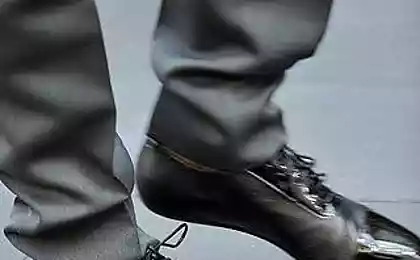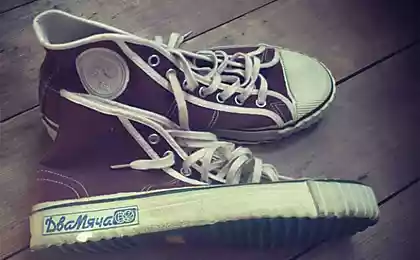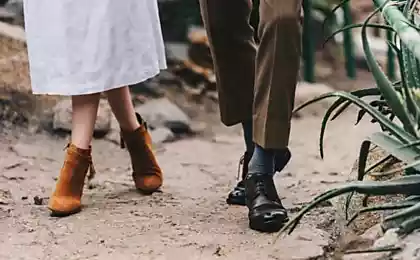1737
Nostalgic sneakers
How convenient and practical sneakers were Soviet, what advantages or disadvantages were before their Western competitors, and, finally, because they are good aesthetically
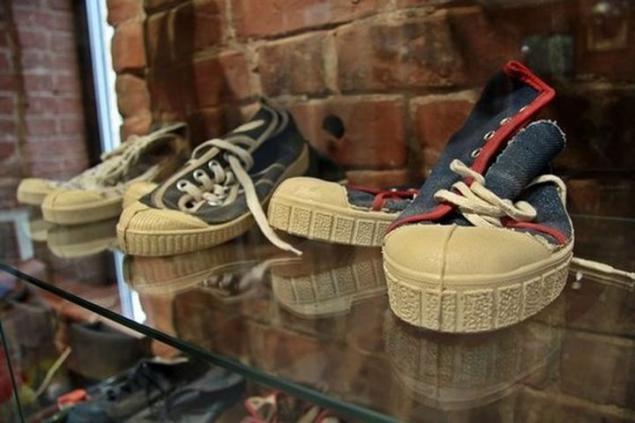
A bit of history
Sneakers abroad
A century ago, shoes were designed for athletes and shoes were champions. Their creators could not imagine that such an invention would be an epoch-making phenomenon and the object of worship of many subcultures and ordinary people around the world.
The first ancestors of sneakers appeared already in the thirties of the XIX century: shoes designed for walking on the beach and was called sand shoes. The modern name appeared in 1916 due to the same brand of shoes Keds.
The history of the brand dates back to 1892, when nine small plants for the production of rubber products have united under the banner of US Rubber Company. In an influential alliance including the company came in and Goodyear, which owned the patent for vulcanization and specialized in the manufacture of rubber shoes with canvas uppers.

Initially, their wares were called peds, according to one version, derived from the Latin «pes» - leg on the other - from the fact that they were poor Americans, which in slang called pedy. The name had to be replaced, because a similar existed. Since the brand was working at a younger audience, the word «peds» crossed with the word «kid» - a teenager. And not for nothing: otherwise we would all still went to pedah.
The boom began in 1917, when the American Marcus Converse released the first batch of sneakers designed for professional basketball, - Converse All Star. Already in 1919 sneakers donned the legendary Chuck Taylor (the first athlete caught in the Basketball Hall of Fame) and became the face of the brand, which is then turned into a Chuck Tayor All Star. Chuck himself stayed away - it will not only increase sales of sneakers, but also to improve them by adding the inside of the circular patch to protect the ankles. Soon, the Converse All Star, even trained athletes. This led to the fact that in 1950 one third of professional NBA players to play a match in Converse. Today, these shoes are breaking all sales records in the segment - in the history of Chucky was booted appearance about 800 million pairs of legs.

1. One of the first conversion. 2. Mr. Chuck Taylor, aka Mr. Basketball, he is chief evangelist ollstarov. 3. Conversion to innovation (well, at the time) technology to protect bones.
However, there were stories in Converse and difficult moments. When the US have connected their forces to the theater of hostilities beginning of the 1940s, the whole textile industry of the country was thrown at providing the army, which is why the production of sneakers suspended, returning to a bygone volumes in 1966. And then the brand has faced competition.
In 1951 Japan - a country where tall people, rather an exception to the rule - there is its basketball shoes. Kihachiro Onitsuka Tiger with Onitsuka (later Asics) released sneakers - OKBasketball. With typical Japanese meticulousness Kihachiro created a unique sole, whose design is borrowed principle of the octopus suckers, provides additional grip gym shoes with platform. In the XXI century reprint this and subsequent models Onitsuka Tiger was superuspeshnym commercial project.
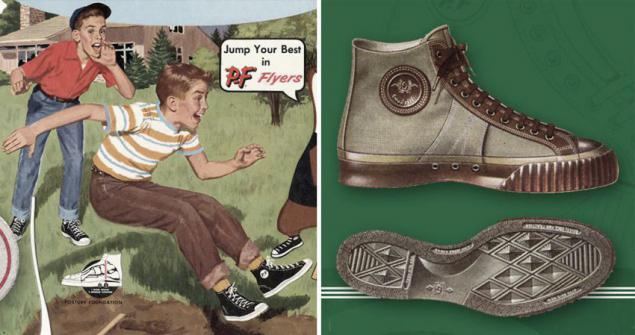
Speaking of commercially successful projects, we should also mention the return of prominent in the 1950s in America, the brand sneakers PFFlyers: in 2001 the right to sneakers, allowing the assurances of advertising, jump higher, bought the company New Balance now ucpeshno sells 20 million pairs retroked in the season.
In the 1980s, there is another shoe that is ideal for active pastime - slipony. Speaking of the Western tradition of using the term: there sliponami called almost any slip-, whether or foppish stylish moccasins Loafer.
Slipony appeared in California through the efforts of Paul van Doren, who founded the brand Vans, and is rumored to not really Radel for its popularization. Everything changed in 1982 after the release of the film "Thoughtless time in the" Ridgemont High "," where Sean Penn in almost every scene appeared in the shoes of Vans.
The film was popular among students, who at that time actively addicted to skateboarding. According to legend, the most popular model Vans - in black-and-white checkered - appeared with their own feed: Paul Van Doren saw the boy's hand painted shoes in this pattern in black marker, and went at them on occasion.
![]()
Sneakers in the USSR
In the 1950s, the popularity of sneakers perehlestnulas even after the Iron Curtain. In 1957, the Union held the Sixth World Festival of Youth and Students, which gathered juniors from all over the world ideologically free. While boys Illustrative families continued to wear patent leather shoes or sandals, and a newfangled kedam addressed progressive and open-minded young people.

The product was sold in the USSR in the cyclopean scale. GOST sneakers appeared soon after the festival, he was assigned to No. 9155-88 and designated "Sport footwear Rubber and rubber».
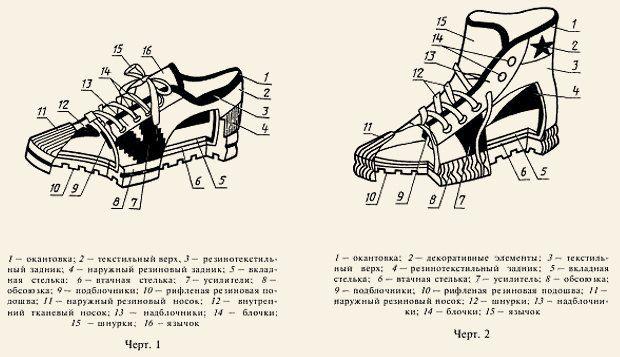
Additional consignment imported, but not of the liberal States. Soviet standards (perhaps from a political standpoint) perfectly match the Chinese and North Korean versions of sport shoes. Since 1968, began to import shoes and Finns - shoes imported under the brand name Nokia, known today in the mobile market. And the design of the logo from the 1960s has not undergone any changes.
The Soviets were not shoes deficit. In 1960, they each wore a scholar. Buy a pair always be in a nearby sporting goods store, so do not hesitate to wear them all day and night and summer and winter, especially since they appeared much more comfortable cheshek outdated. Ten years after the Youth Festival gym shoes we are already so entrenched in Soviet life that became its essential attribute, and every student in the physical education grew in line in them. In 1967, the country came to an American reporter Bill Eppridzh who took here the famous reportage Soviet Youth, and images show that the majority of Soviet youth is already sneakers.

In 1979, the novel "It's me, Eddie," Eduard Limonov calls them in his own way, "sneakers" and in this way gives them a place in Soviet literature. And Viktor Tsoi, also like sneakers, and will plant them in the musical culture of the country. Sneakers infiltrated in the Soviet cinema - boy android electronics adventurers Petrov Vasechkin, balls of "Buttermilk" and sprightly cartoon wolf from "Well, wait!" - They portrayed is not glazed kinoobraz and ordinary guys in sneakers.
![]()
1. Syroezhkin sneakers. 2. Ball of "Buttermilk". Instead of useful things in the household bought sneakers and a camera gun. 3. Wolf of "Well, wait!". 4. Viktor Tsoi in sneakers. 5. Students in fizre. 6. Classic Soviet sports bow. 7. Holders of "two goals" do not leave them even on the beach. 8. The boys in the camp. 9. The Boy in Chinese sneakers "Two Ball" flirts with the girl in the less prestigious Lithuanian sneakers Inkaras Kaunas. 10. Sneakers on outdoor grows. 11. Boys play street ball.

What were the Soviet sneakers
Soviet sneakers were the sole bright red shades or with clear suture passing in textile top usually blue or black. Shoelaces most were white and had a metal tip. Most Soviet models on the inner side of the ankle were seen in the area around the protective stripe, stylized ball.

The ultimate dream of Chinese-made shoes were "two goals", they were not in the Soviet example of quality, it was more difficult to get them, and coloring and design at the same time different from the common patterns that made them the subject of worship. Sneakers blue differ more solid green soles and trim, toe and laces were white. From the inside, near the bone, includes a round emblem with two balls - soccer and basketball.
The most precious commodity was completely white sneakers "Two goals." They cost four rubles, and like them, the Chinese and Vietnamese Warrior Forward - three.
![]()
Source: asaratov.livejournal.com

A bit of history
Sneakers abroad
A century ago, shoes were designed for athletes and shoes were champions. Their creators could not imagine that such an invention would be an epoch-making phenomenon and the object of worship of many subcultures and ordinary people around the world.
The first ancestors of sneakers appeared already in the thirties of the XIX century: shoes designed for walking on the beach and was called sand shoes. The modern name appeared in 1916 due to the same brand of shoes Keds.
The history of the brand dates back to 1892, when nine small plants for the production of rubber products have united under the banner of US Rubber Company. In an influential alliance including the company came in and Goodyear, which owned the patent for vulcanization and specialized in the manufacture of rubber shoes with canvas uppers.

Initially, their wares were called peds, according to one version, derived from the Latin «pes» - leg on the other - from the fact that they were poor Americans, which in slang called pedy. The name had to be replaced, because a similar existed. Since the brand was working at a younger audience, the word «peds» crossed with the word «kid» - a teenager. And not for nothing: otherwise we would all still went to pedah.
The boom began in 1917, when the American Marcus Converse released the first batch of sneakers designed for professional basketball, - Converse All Star. Already in 1919 sneakers donned the legendary Chuck Taylor (the first athlete caught in the Basketball Hall of Fame) and became the face of the brand, which is then turned into a Chuck Tayor All Star. Chuck himself stayed away - it will not only increase sales of sneakers, but also to improve them by adding the inside of the circular patch to protect the ankles. Soon, the Converse All Star, even trained athletes. This led to the fact that in 1950 one third of professional NBA players to play a match in Converse. Today, these shoes are breaking all sales records in the segment - in the history of Chucky was booted appearance about 800 million pairs of legs.

1. One of the first conversion. 2. Mr. Chuck Taylor, aka Mr. Basketball, he is chief evangelist ollstarov. 3. Conversion to innovation (well, at the time) technology to protect bones.
However, there were stories in Converse and difficult moments. When the US have connected their forces to the theater of hostilities beginning of the 1940s, the whole textile industry of the country was thrown at providing the army, which is why the production of sneakers suspended, returning to a bygone volumes in 1966. And then the brand has faced competition.
In 1951 Japan - a country where tall people, rather an exception to the rule - there is its basketball shoes. Kihachiro Onitsuka Tiger with Onitsuka (later Asics) released sneakers - OKBasketball. With typical Japanese meticulousness Kihachiro created a unique sole, whose design is borrowed principle of the octopus suckers, provides additional grip gym shoes with platform. In the XXI century reprint this and subsequent models Onitsuka Tiger was superuspeshnym commercial project.

Speaking of commercially successful projects, we should also mention the return of prominent in the 1950s in America, the brand sneakers PFFlyers: in 2001 the right to sneakers, allowing the assurances of advertising, jump higher, bought the company New Balance now ucpeshno sells 20 million pairs retroked in the season.
In the 1980s, there is another shoe that is ideal for active pastime - slipony. Speaking of the Western tradition of using the term: there sliponami called almost any slip-, whether or foppish stylish moccasins Loafer.
Slipony appeared in California through the efforts of Paul van Doren, who founded the brand Vans, and is rumored to not really Radel for its popularization. Everything changed in 1982 after the release of the film "Thoughtless time in the" Ridgemont High "," where Sean Penn in almost every scene appeared in the shoes of Vans.
The film was popular among students, who at that time actively addicted to skateboarding. According to legend, the most popular model Vans - in black-and-white checkered - appeared with their own feed: Paul Van Doren saw the boy's hand painted shoes in this pattern in black marker, and went at them on occasion.
Sneakers in the USSR
In the 1950s, the popularity of sneakers perehlestnulas even after the Iron Curtain. In 1957, the Union held the Sixth World Festival of Youth and Students, which gathered juniors from all over the world ideologically free. While boys Illustrative families continued to wear patent leather shoes or sandals, and a newfangled kedam addressed progressive and open-minded young people.

The product was sold in the USSR in the cyclopean scale. GOST sneakers appeared soon after the festival, he was assigned to No. 9155-88 and designated "Sport footwear Rubber and rubber».

Additional consignment imported, but not of the liberal States. Soviet standards (perhaps from a political standpoint) perfectly match the Chinese and North Korean versions of sport shoes. Since 1968, began to import shoes and Finns - shoes imported under the brand name Nokia, known today in the mobile market. And the design of the logo from the 1960s has not undergone any changes.
The Soviets were not shoes deficit. In 1960, they each wore a scholar. Buy a pair always be in a nearby sporting goods store, so do not hesitate to wear them all day and night and summer and winter, especially since they appeared much more comfortable cheshek outdated. Ten years after the Youth Festival gym shoes we are already so entrenched in Soviet life that became its essential attribute, and every student in the physical education grew in line in them. In 1967, the country came to an American reporter Bill Eppridzh who took here the famous reportage Soviet Youth, and images show that the majority of Soviet youth is already sneakers.

In 1979, the novel "It's me, Eddie," Eduard Limonov calls them in his own way, "sneakers" and in this way gives them a place in Soviet literature. And Viktor Tsoi, also like sneakers, and will plant them in the musical culture of the country. Sneakers infiltrated in the Soviet cinema - boy android electronics adventurers Petrov Vasechkin, balls of "Buttermilk" and sprightly cartoon wolf from "Well, wait!" - They portrayed is not glazed kinoobraz and ordinary guys in sneakers.
1. Syroezhkin sneakers. 2. Ball of "Buttermilk". Instead of useful things in the household bought sneakers and a camera gun. 3. Wolf of "Well, wait!". 4. Viktor Tsoi in sneakers. 5. Students in fizre. 6. Classic Soviet sports bow. 7. Holders of "two goals" do not leave them even on the beach. 8. The boys in the camp. 9. The Boy in Chinese sneakers "Two Ball" flirts with the girl in the less prestigious Lithuanian sneakers Inkaras Kaunas. 10. Sneakers on outdoor grows. 11. Boys play street ball.

What were the Soviet sneakers
Soviet sneakers were the sole bright red shades or with clear suture passing in textile top usually blue or black. Shoelaces most were white and had a metal tip. Most Soviet models on the inner side of the ankle were seen in the area around the protective stripe, stylized ball.

The ultimate dream of Chinese-made shoes were "two goals", they were not in the Soviet example of quality, it was more difficult to get them, and coloring and design at the same time different from the common patterns that made them the subject of worship. Sneakers blue differ more solid green soles and trim, toe and laces were white. From the inside, near the bone, includes a round emblem with two balls - soccer and basketball.
The most precious commodity was completely white sneakers "Two goals." They cost four rubles, and like them, the Chinese and Vietnamese Warrior Forward - three.
Source: asaratov.livejournal.com



